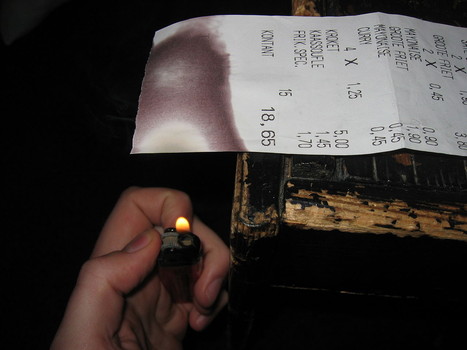Annette M. Hormann and colleagues from the University of Missouri and the Universite´ de Toulouse in France reported that the presently used methods of testing for the transfer of bisphenol-A (BPA) from thermal receipts to people’s hands used by the FDA is not representative of reality. The researchers show that as much as 20 milligrams of BPA per gram of paper is a reasonable expectation for common levels of exposure.
The researchers showed through experiment that sufficient BPA could remain on the hands of people that consistently handled thermal receipt paper to cause the transfer of enough BPA to food that exceeds the limits set by the FDA. BPA has been linked with obesity and a number of hormonal diseases but sufficient evidence that BPA exposure from thermal receipt paper was high enough to represent a health danger has not been presented before. The researchers claim that their work is the first to prove BPA in thermal receipt paper does transfer to humans in sufficient quantities to account for the levels of BPA seen in sampling of urine and other body fluids that has been the basis for the claim that BPA causes diseases.
Paul Hamaker received the analysis below directly from the American Chemistry Council. The American Chemistry Council in part represents the interest of chemical manufacturers. That fact should not be construed in any way as a bias or a cause to misrepresent fact.
The American Chemistry Council (ACC) offers the following comments regarding the release of the study published today in the journal PLOS ONE on exposure to BPA from handling thermal receipt paper. Quotes from the following may be attributed to Dr. Steven G. Hentges of ACC’s Polycarbonate/BPA Global Group.
“Due to the use of unrealistic experimental conditions, much of the data presented in this new study has very limited relevance to the potential for human exposure to BPA from handling thermal receipt paper. Although downplayed in the publication, the most relevant data shows very little BPA exposure under conditions most representative of real-life contact with thermal receipt paper.”
“Notably, a recent study from the Finnish Institute of Occupational Health found no significant exposure to BPA from handling receipt paper using real-life exposure scenarios. Included in the Finnish study were conditions representative of cashiers (i.e., repeated handling of receipts throughout a workday) and more intensive short-term handling considered to be beyond normal handling of paper receipts.”
“Consistent with these measurements of low exposure from handling thermal receipt paper, recent biomonitoring data from the U. S. Centers for Disease Control and Prevention (CDC) demonstrate that consumer exposure to BPA – from all sources – is extremely low. Typical BPA exposure from all sources is about 1,000 times below safe intake levels set by government bodies in the U. S., Canada and Europe.” “The U. S. Food and Drug Administration (FDA) has said unequivocally that BPA is safe for use in food contact materials. FDA’s current perspective is based on its review of hundreds of studies, as well as its comprehensive research on BPA.”
Thermal receipt paper and BPA may become a hotter topic than previously seen due to the new report. Both sides of the disagreement deserve equal representation. The idea that thermal receipt paper that may contain BPA could or should be banished from use is at present economically unrealistic.















